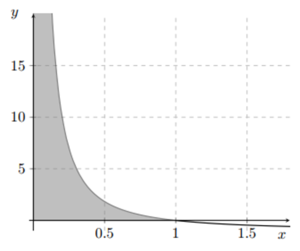Science:Math Exam Resources/Courses/MATH103/April 2017/Question 06 (b)
{{#incat:MER QGQ flag|{{#incat:MER QGH flag|{{#incat:MER QGS flag|}}}}}}
• Q1 (a) • Q1 (b) • Q1 (c) • Q1 (d) • Q1 (e) (i) • Q1 (e) (ii) • Q1 (e) (iii) • Q1 (f) • Q2 (a) • Q2 (b) (i) • Q2 (b) (ii) • Q2 (c) • Q3 (a) • Q3 (b) • Q3 (c) • Q3 (d) • Q4 • Q5 • Q6 (a) • Q6 (b) • Q7 (a) • Q7 (b) • Q7 (c) • Q8 (a) • Q8 (b) • Q8 (c) • Q9 (a) • Q9 (b) • Q9 (c) • Q9 (d) • Q9 (e) •
Question 06 (b) |
|---|
|
Consider the function . (b) Calculate the volume of the solid of revolution, , obtained by rotating the above area (shaded area in figure) around the -axis or show that it does not exist. |
|
Make sure you understand the problem fully: What is the question asking you to do? Are there specific conditions or constraints that you should take note of? How will you know if your answer is correct from your work only? Can you rephrase the question in your own words in a way that makes sense to you? |
|
If you are stuck, check the hint below. Consider it for a while. Does it give you a new idea on how to approach the problem? If so, try it! |
Hint |
|---|
|
Recall the formula used to calculate this type of volume of revolution. Using this formula, set up your problem using an integral, and note that the volume of revolution is obtained by rotating about the -axis. Then, like in part a), integrate the integrand in order to more effectively see how to determine this integral. |
|
Checking a solution serves two purposes: helping you if, after having used the hint, you still are stuck on the problem; or if you have solved the problem and would like to check your work.
|
Solution 1 |
|---|
|
The formula for calculating the desired volume, given the function , is
(a way to remember this is to recall the formula for the volume of a cylinder and to visualize cylinders centered at the -axis overlapping with the volume being calculated). The problem is to find when we are only given . Fortunately, we know that is strictly decreasing, so we can obtain by writing out the equation for then solving for .
So, and the desired integral becomes
To evaluate this integral, we first use the Power Rule to integrate the integrand:
The above function indicates that the integral is improper and that it should be evaluated like so.
By the Fundamental Theorem of Calculus,
and as ,
So, the volume is
|
Solution 2 |
|---|
|
The volume of this solid can also be computed using the shell method. Recall that the shell method gives the volume of a surface of revolution about the -axis as
Where is the height of each shell. In this case, we have , so the volume is
Answer: |
{{#incat:MER CT flag||
}}























![{\displaystyle {\begin{aligned}&2\pi \int _{0}^{1}x(x^{-3/2}-1)\,dx\\=&2\pi \int _{0}^{1}x^{-1/2}-x\,dx\\=&2\pi \left[2x^{1/2}-{\frac {1}{2}}x^{2}\right]_{0}^{1}\\=&2\pi \left[2(1)^{1/2}-{\frac {1}{2}}(1)^{2}-2(0)^{1/2}+{\frac {1}{2}}(0)^{2}\right]\\=&2\pi \left[2-{\frac {1}{2}}\right]\\=&2\pi \left({\frac {3}{2}}\right)\\=&3\pi .\end{aligned}}}](https://wiki.ubc.ca/api/rest_v1/media/math/render/svg/7b89cae9e5176ac35729c11f65d9ab8fe88bc152)
